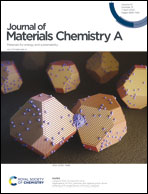Investigating dry room compatibility of sulfide solid-state electrolytes for scalable manufacturing†
Abstract
All-solid-state batteries (ASSBs) are viewed as promising next-generation energy storage devices, due to their enhanced safety by replacing organic liquid electrolytes with non-flammable solid-state electrolytes (SSEs). The high ionic conductivity and low Young's modulus of sulfide SSEs make them suitable candidates for commercial ASSBs. Nevertheless, sulfide SSEs are generally reported to be unstable in ambient air. Moreover, instead of gloveboxes used for laboratory scale studies, large scale production of batteries is usually conducted in dry rooms. Thus, this study aims to elucidate the chemical evolution of a sulfide electrolyte, Li6PS5Cl (LPSCl), during air exposure and to evaluate its dry room compatibility. When LPSCl is exposed to ambient air, hydrolysis, hydration, and carbonate formation can occur. Moreover, hydrolysis can lead to irreversible sulfur loss and therefore LPSCl cannot be fully recovered in the subsequent heat treatment. During heat treatment, exposed LPSCl undergoes dehydration, decomposition of carbonate species, and reformation of the LPSCl phase. Finally, LPSCl was found to exhibit good stability in a dry room environment and was subject to only minor conductivity loss due to carbonate formation. The dry room exposed LPSCl sample was tested in a LiNi0.8Co0.1Mn0.1O2|LiIn half-cell, exhibiting no significant loss of electrochemical performance compared with the pristine LPSCl, proving it to be compatible with dry room manufacturing processes.



 Please wait while we load your content...
Please wait while we load your content...